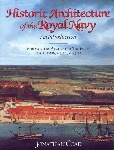Historic Architecture of the Royal Navy
Last updated: 17.12.19

| Printed: | 1983 | Author: | J.G. Coad |
| Publisher: | Victor Gollanz Ltd | ISBN: | 0 575 03277 4 |
| Copyright: | J.G. Coad 1983 | ||
| Suppliers: | 




|
Publisher's blurb
From the 1690s to the First World War, British maritime power, though often challenged, ruled supreme. It was a key factor in the nation's commercial growth which fuelled and underpinned industrial and imperial expansion. Central to the creation and maintenance of that supremacy were the royal dockyards, the victualling and ordnance yards, and the naval hospitals. Without these there could have been no Royal Navy, and Britain's modern history would have been very different.
Historic Architecture of the Royal Navy concentrates on the period from 1700 to 1900, with particular emphasis on the dockyards built to service the sailing navy. They are rich in naval and architectural history and were industrial centres in England well before the Industrial Revolution. They go far towards explaining how it was that Britain was able to maintain and sustain one of the greatest navies the world has seen. With numerous illustrations featuring surviving buildings in Chatham, Sheerness, Portsmouth, Devonport, Harwich, Gibraltar, Minorca, Malta, Bermuda and Antigua, Historic Architecture of the Royal Navy is a fascinating and important book.
Jonathan Coad joined the former Ministry of Public Building and Works in 1966 as an Assistant Inspector of Ancient Monuments. One of his first tasks was to assess the historic importance of buildings and equipment in the royal dockyards. From there his interests extended to former bases at home and abroad. He is a council member of the Navy Records Society and the Society for Nautical Research, a member of the Victory Advisory Technical Committee and a Fellow of the Society of Antiquaries. Historic Architecture of the Royal Navy is the product of fifteen years of mostly spare-time research.
Personal remarks:
This is indeed a fascinating book showing that a navy is not just ships, admirals and hearty jack tars. After reading it. it is easy to understand stand the proud claim that since the time of Pepys, no British seaman has been starved of rations and that munitions were never exhausted.

